 How can you tell if your student recruitment content is effective? While the ROI of some elements of the digital marketing mix – like paid advertising – can be easily estimated based on few clear key performance indicators (KPIs), content marketing is a bit more abstract. The role of things like blogs, infographics, and videos in nurturing students towards enrollment is often a little more indirect, which can make it harder for schools to pinpoint what is working and what isn’t.
How can you tell if your student recruitment content is effective? While the ROI of some elements of the digital marketing mix – like paid advertising – can be easily estimated based on few clear key performance indicators (KPIs), content marketing is a bit more abstract. The role of things like blogs, infographics, and videos in nurturing students towards enrollment is often a little more indirect, which can make it harder for schools to pinpoint what is working and what isn’t.
However, that doesn’t mean that it can’t be measured. Using a number of different data sources, including both search and social analytics tools as well as CRM and marketing automation reporting, your school can easily pinpoint a number of important metrics that will tell you a lot about the impact of your content marketing efforts.
Keep reading to learn what KPIs are important in content marketing, what they tell you, and where to find them.
Is Your Higher Education Content Driving Traffic to Your Website?
A good content marketing strategy will have a noticeable impact on user activity on your website. Having relevant, interesting content should lead to more people finding your site online, which in turn builds more awareness of your school and programs, resulting in more traffic and inquiries and helping to enhance your SEO authority.
How do you figure out if this is happening? A good place to start is by looking at your basic traffic metrics, most of which you’ll find in the Audience Overview report in Google Analytics:
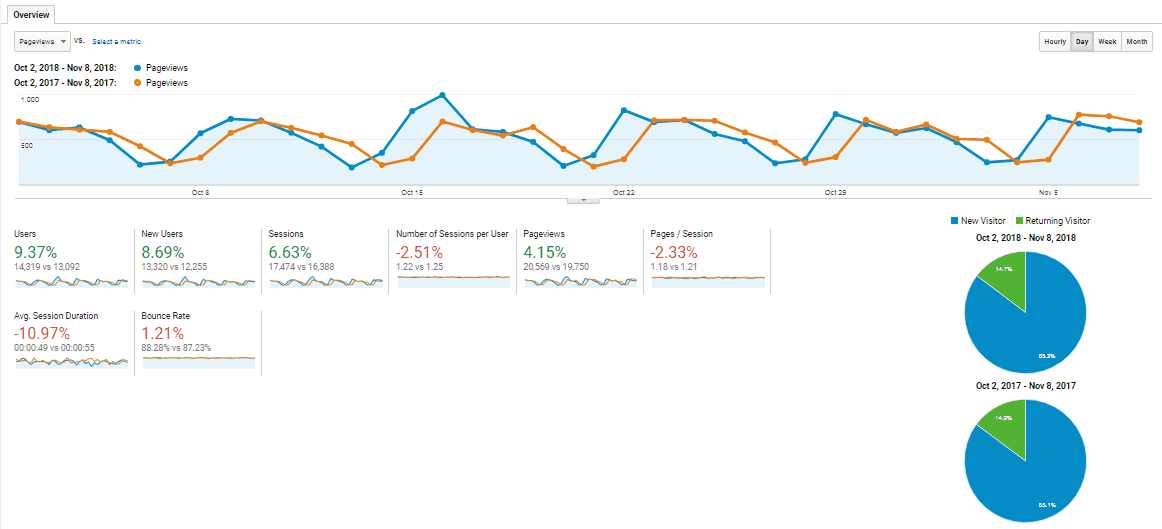
Traffic in GA is measured in both users and sessions. The Users figure is the amount of unique visitors to your website, meaning that each IP address is counted only once. The Sessions figure on the other hand, counts every single visit to the site.
The amount of users and sessions you should be hoping to attract will differ greatly depending on the size and profile of your school, as well as your existing online authority. The longer you have been investing in publishing content regularly, the more traffic you can expect.
With that in mind, comparing these metrics with past performance can be the best approach to determining how well your efforts are working. For schools, a year over year comparison is often the best approach, as the seasonality of the enrollment cycle can lead to large variations in traffic on a month to month basis.
In the above sample report, you can see that both traffic and sessions have grown compared to this time last year. The pie chart on the right hand side divides users into New and Returning Visitors. How large a ratio of each you should have largely depends on your aims, but for schools focusing on student recruitment, a larger proportion of new users should be desirable.
Of course, traffic alone is not a measure of the effectiveness of your content, just as content in and of itself isn’t always necessarily the reason for increases or decreases in traffic. To get a better sense of just how indicative these figures are, you should analyze your Acquisition Reports to see where your traffic is coming from.
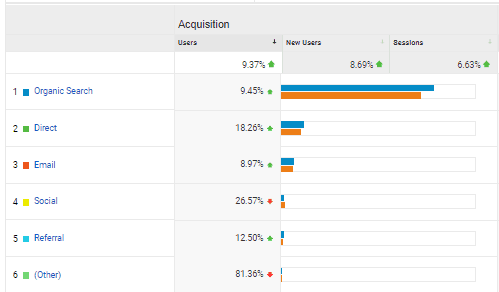
Because digital marketing relies on initiatives across a range of channels complementing each other, any changes you have made in your approach in areas like email marketing, social media, advertising or even your offline marketing efforts could account for any improvement or deterioration in your results.
Measuring Engagement in Content Marketing for Education
Perhaps above all else, good education marketing content should be engaging. It should draw prospective students in, inspire them, and leave them excited to find out more about your school and its courses.
With that in mind, it’s important to delve deeper into your data to determine just how engaging your content really is. A couple of useful metrics here can give you a bit more insight:
Session Duration: Available in the Audiences report in GA, this is the average amount of time each session on your website lasts. Don’t be too discouraged if this number is low. Tony Haile of Chartbeat wrote in Time Magazine in 2015 that according his company’s research, 55% of web users will only spend around 15 seconds on a single site. Taking this into account, durations averaged out over all of your users is bound to be low enough. Nonetheless, comparing it year on year for increases and decreases can help you know if you’re getting better results.
Average Time on Page: This metric is a bit more instructive, and measures the average time spent on single pages. When it comes to content, this can be very telling. A healthy average will indicate that people are reading or watching your content all the way through.
Example: The Average Time on Page here is around four and a half minutes, which is fairly healthy. The metric is also improving year over year.

Bounce Rate: The bounce rate is the amount of users who visit a single page and then exit your site without taking any action. While some argue that this is gives a good indication of how well your site is hooking readers, others dispute its importance. Marketing expert Neil Patel, for instance, argues that since a user who read a full article on your site, got the information they wanted, and then left would still be counted as a bounce, the data doesn’t necessarily tell you much about the overall quality of your posts. He argues that bounce rates are much more influenced by UX than actual content.
Pages Per Session: The average amount of unique pages each user views during a session.

Comparing this metric can be very revealing. The aim of much inbound marketing content is to encourage prospective students to click through on a CTA, a service page, or a link to another post on the website in order to nurture them towards enrollment. If you find this figure is dropping it could be a sign that you should start putting more internal links in your posts, or that your existing links and CTAs could be more enticing.
To go even deeper, you can also use your social analytics tools for some indication of how engaging your posts are. If you use your social media accounts to share new content, gauging reactions, comments, and shares can be a good way to estimate how well it is being received.
Example: This news post from the University of Manitoba received 164 reactions and 51 shares after it was posted to Facebook.

Be careful about putting too much stock in these figures, however. While reactions like Facebook Likes can be valuable in boosting your reach on the social network itself, it isn’t necessarily indicative of people reading or viewing your content. The amount of shares a post receives on social media can be much more valuable, although even this has been disputed among experts. In his aforementioned Time Magazine article, for instance, Tony Haile illustrated that social media users actually spent very little time reading the content of articles they shared:

While less qualitative, looking at your comments on social media can actually be a better measure. A post that is attracting compliments, or better yet, questions and discussion from your audience is likely to be a winner.
You should also use social analytics tools like Facebook Insights to measure the amount of link clicks your content is getting. This can help you determine whether you are producing material that really appeals to that audience.

Measuring the SEO Performance of Your School’s Content
Of course, one of the main goals of much of your website content will be to improve your school’s rankings in organic search, so measuring the SEO impact of individual posts is a must. This will do much more than tell you how well it is optimized for certain keywords; the complex algorithms of modern search engines are designed to reward pages which demonstrate quality, relevance, and user appeal, all of which your school should be striving for in its inbound marketing efforts.
Previously mentioned GA metrics like traffic and time spent on page can all be good SEO indicators, but you should also track the success of your content in keyword rankings you are targeting. This will help you see if what you are producing is fully optimized, and useful to web users carrying out those searches. A keyword tracking tool like Moz is ideal for this purpose.
Example: A Snippet from a Moz report for a private career college in Canada. The middle column shows whether the school has moved up or down in the rankings for particular keywords, while the URL column on the right hand side will tell you which web page is achieving that ranking in search results.

Another fantastic tool for measuring your SEO efforts is the Search Analytics section in Google Search Console. Previously known as Webmaster Tools, Search Console is a free service that allows website owners to manage and monitor their presence in Google search results. Under the performance tab in the tool, traffic to each of your pages is evaluated and ranked according to four important KPIs:
- Clicks: The total amount of clicks on your site or an individual page
- Impressions: The amount of times your pages were shown to users in search results
- Average CTR: The percentage of impressions that resulted in a click
- Average Position: The average ranking of your pages in search results
You can drill down into these metrics in a number of ways to gain fascinating insights. The Queries tab will tell you the most popular searches that your pages are appearing in, and can be sorted based on any of the above four metrics. Often these are rather different than the keywords you are trying to rank for, and can give your team a number of ideas for strategic search terms to target:

The Pages tab, meanwhile, will show you the most popular pages on your site. Each page’s performance can be measured based on the aforementioned four metrics, and you can also click on an individual page and use the queries tab to find out what searches are driving traffic to it:
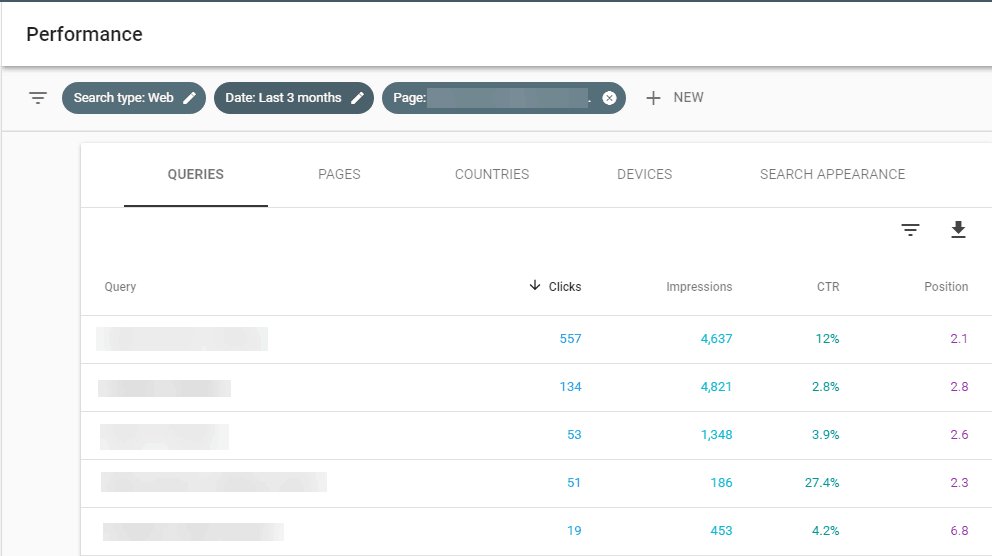
You can reverse this process too, looking at individual queries and finding which pages are ranking for them:
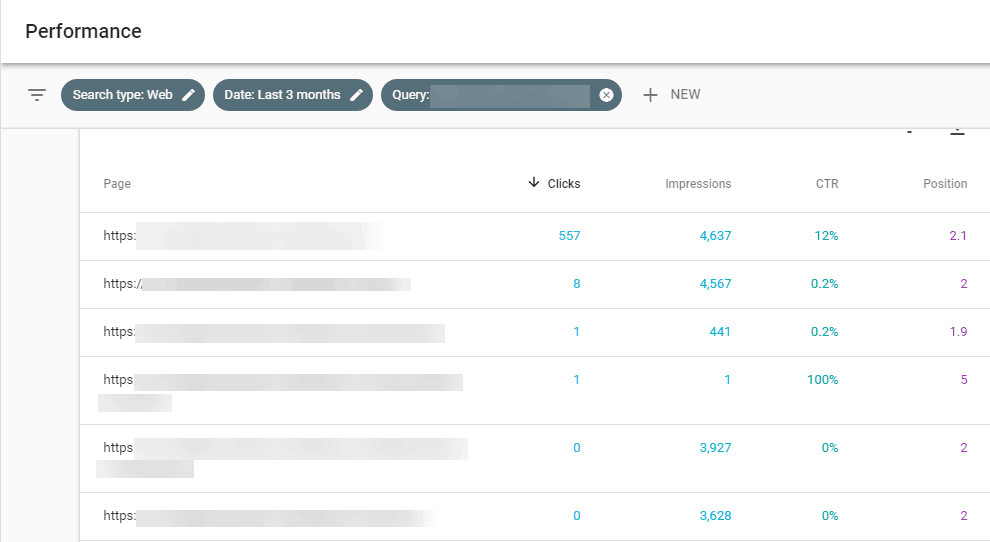
You can also monitor your search results by country, device, or web light results (simplified web pages Google creates for slow mobile connections), although the last two are far more indicative of UX than content quality. Again, you can view your overall results, or click each tab to see results for individual pages, queries, locations, or channels. All of these KPIs can be compared over whatever date range you specify, making it easy to see any real-time increases or declines in your reach.
One thing that’s important to remember when measuring the SEO impact of your content is that new posts can take some time to start gaining traction in the current search landscape. As Google values page authority highly, it can take a while for it to build, and many top content producers like HubSpot and Search Engine Journal estimate that the average ‘ramp up’ time for content can be as long as two months. So if your new posts aren’t getting the attention you think they should, don’t be disheartened, as they may still shoot up in the rankings given enough time.
Measuring How Well Your Content is Nurturing Prospective Students Towards Enrollment
As much as these KPIs will give you an indication of your success in terms of creating quality, visible content marketing for education, they won’t tell you exactly how much it is influencing your lead generation efforts. This can be tricky to do, since content should be designed to guide prospective students through each stage of the enrollment journey, meaning not all of your posts should be expected to lead directly to conversions.
However, you can still gain some insight into which content is helping leads progress through the funnel by looking at various data sources. On a macro level, comparing your overall lead generation and conversion success year over year can give you an indication of how well your overall content marketing mix is serving its purpose. Beyond that, marketing automation reporting can be a good way to determine how much leads are being nurtured through your enrollment funnel directly as a result of your content marketing as opposed to other channels.
Example: This Mautic report shows the amount of leads generated by a school through each of its main channels.

Depending on the platform you are using, you may also have access to additional reports which further illuminate what content is driving prospective students towards enrollment.
Example: Schools who publish blogs directly through HubSpot’s platform can access a range of data about each individual posts’ success.

GA can also offer some valuable insights into this area. If you have goals set up on your school’s site, you can view your conversion rates in the Landing Pages report to identify content which is driving conversions:
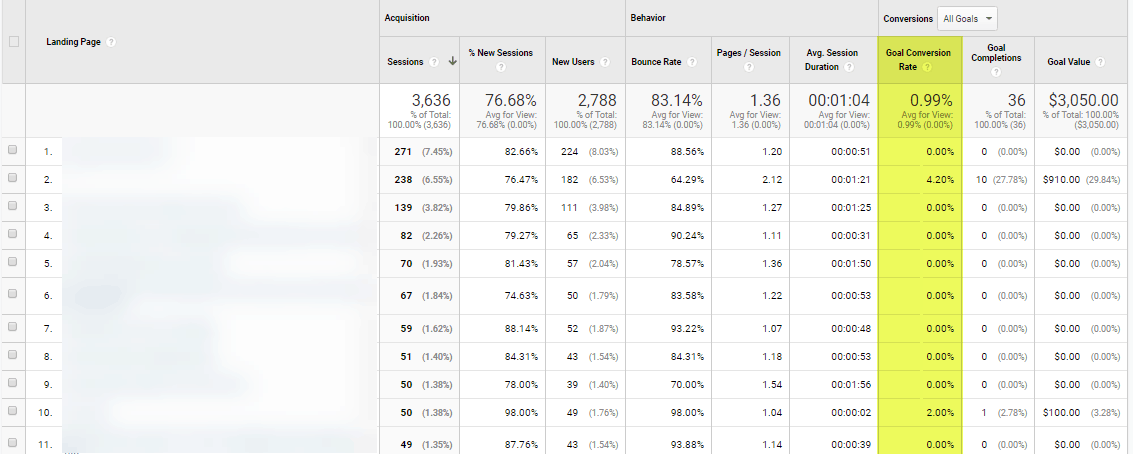
Of course, not all of your pages will drive a prospective student directly towards your goals. For a more nuanced view, look at the Page Value Google has assigned to each page, which can be found in the All Pages report. The Page Value gives you an indication of the propensity of a user to convert on one of your goals after seeing that particular page.
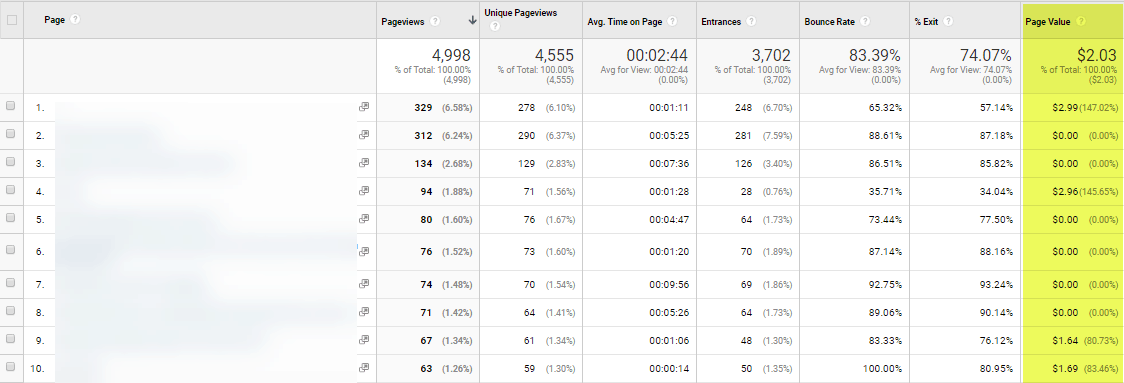
While none of these metrics provide a magic formula for determining the overall success of your content marketing for education, each can offer its own insight and value that can help you to put the ROI of this area into more tangible terms. By continuing to monitor each of these KPIs and comparing them to your past results, you will get a sense of just how far your content has come, and what you need to do to take it further.







